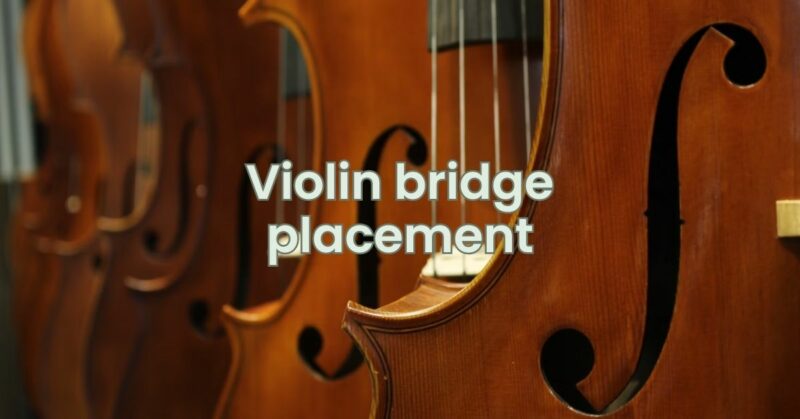The violin bridge placement is a critical aspect of setting up the instrument for optimal playability, sound projection, and tonal quality. Positioned between the soundholes, the bridge serves as a crucial link between the strings and the violin’s top plate, transmitting the vibrations from the strings to produce its beautiful sound. Proper bridge placement is essential to ensure the correct string height, string spacing, and overall alignment, allowing the violin to achieve its full musical potential. In this comprehensive guide, we will explore the significance of violin bridge placement and the steps to achieve precise and effective positioning.
Importance of Violin Bridge Placement:
- String Height: The placement of the bridge determines the height of the strings above the fingerboard. Proper string height is vital for comfortable playing and accurate intonation. A well-positioned bridge ensures that the strings are neither too high nor too low, allowing for easy fingering without excessive effort or buzzing.
- String Spacing: The bridge placement also influences the spacing of the strings across the fingerboard. Correctly aligned strings result in consistent fingering and bowing techniques, facilitating ease of playing and better intonation.
- Sound Projection: The precise placement of the bridge is crucial for sound projection and resonance. An optimally positioned bridge transmits the vibrations of the strings to the violin’s body effectively, resulting in a clear, resonant, and projecting tone.
Steps to Achieve Precise Violin Bridge Placement:
- Loosen the Strings: Before positioning the bridge, loosen the tension of the strings by turning the corresponding fine tuners or pegs. This step prevents excessive pressure on the violin and minimizes the risk of damaging the bridge or the soundpost.
- Align with the Notches: Position the bridge between the soundholes, ensuring that the feet of the bridge align with the notches carved into the violin’s top plate. The notches are guide markers that indicate the correct placement of the bridge on the violin.
- Parallel to the Fingerboard: Ensure that the bridge is positioned perpendicular to the fingerboard. Use a bridge setter or a pencil as a reference guide to achieve the right alignment. The strings should be parallel to the fingerboard, allowing for consistent finger placement and bowing.
- Maintain the Arc Shape: As you position the bridge, be mindful of maintaining the natural arc shape of the bridge. The feet of the bridge should rest evenly on the top plate, ensuring an even distribution of pressure and contact with the violin’s body.
- Check String Alignment: Observe the strings from the top view to check that they are aligned correctly along the fingerboard. Each string should be equidistant from the edge of the fingerboard, ensuring uniform string spacing.
- Check Bridge Height: Verify that the bridge height is appropriate by using a ruler or specialized tool to measure the distance between the strings and the fingerboard. The standard bridge height is typically around 33-35 mm from the top plate.
- Tune the Violin: After positioning the bridge, gradually tighten the strings using the fine tuners or pegs while maintaining even pressure on the bridge. Tune the violin to the desired pitch, checking the bridge alignment and making any final adjustments if necessary.
Conclusion:
Violin bridge placement is a meticulous process that significantly impacts the instrument’s playability, sound projection, and tonal quality. Properly aligning the bridge ensures the correct string height and spacing, resulting in comfortable playing and accurate intonation. Sound vibrations are efficiently transmitted to the violin’s body, producing a clear, resonant, and projecting tone. Take care to maintain the natural arc shape of the bridge and ensure that it is perpendicular to the fingerboard. By following the steps outlined in this guide, you can achieve precise violin bridge placement and unlock the full musical potential of your instrument. For the best results, consider seeking assistance from a qualified violin luthier or instructor, who can provide valuable insights and expertise in bridge placement and overall violin setup. With the correct bridge positioning, your violin will continue to delight and inspire you as you embark on your musical journey.

